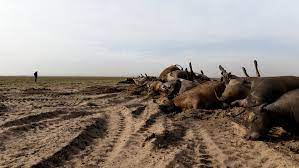By DTN
The current heat wave blazing through Kansas feedlots has killed an estimated 10,000 head of fat cattle.
Final death numbers continue to come in, but that early estimate was shared with DTN by livestock experts, who put the geographical center point for those deaths at Ulysses, Kansas.
What is known is that leading up to these losses, temperatures in the area were over 100 degrees Fahrenheit, there was the humidity, and there was little to no wind to help cool the animals. Temperature readings reported for Ulysses began to exceed the 100-degree mark on June 11. By June 13, the high temperature was reported at 104 degrees, with humidity levels ranging from 18% to 35%. Temperature and humidity levels began to break some on June 14. Just a few days prior to the heat setting in, highs had been in the 80s.
Corbitt Wall, a cattle analyst with National Beef Wire who works out of Amarillo, Texas, said he heard from two non-media sources about the extent of the Kansas losses. He noted there was frustration that despite such extensive losses, the futures market fell Monday.
Large losses in feedlots due to heat stress seem to start every year around June, said veterinarian A.J. Tarpoff, who works with Kansas State University Extension. He explained that when there is a “perfect storm” of too much heat and no opportunity for nighttime cooling, cattle can accumulate heat and die from the stress. It’s a situation, he added, that can hit both feedlot and grazing animals.
“Heat stress doesn’t happen all at one time. Cattle accumulate heat during the day, and then over the nighttime hours, it takes four to six hours for them to dissipate that heat. As long as we have a cooling effect at night, cattle can mostly handle the heat. Where we run into issues is where we have two to four days in a row of minimal nighttime cooling, and we start the day with the heat load we accumulated the day before still there,” he said.
Tarpoff worked as an associate feedlot veterinarian in Canada before moving to Kansas. He said it’s not uncommon to see issues with heat stress even that far north. And he pointed out that not all animals within a herd, group, or pen are affected by heat stress in the same way. A previous bout with respiratory disease that may have led to scarred lungs can make it difficult for that animal to cool itself. And there are other pretty basic reasons some cattle just don’t handle the heat as well as others.
“The second week of June is when, historically, we start to see this, and I think a lot of it has to do with the hair coat. Cattle can adapt to almost any environment on earth, but they need time. At this point in the season, a lot of them have not fully shed that winter hair coat and slicked off,” he said, adding that the fact that the majority of the U.S. cow herd is black also means they can’t cool as efficiently.
In this most recent reported loss, many of the animals appeared close to going to processors. They were fat, and Tarpoff added that in cases like this, once these layers of fat develop, it can put animals at more risk of heat stress.

